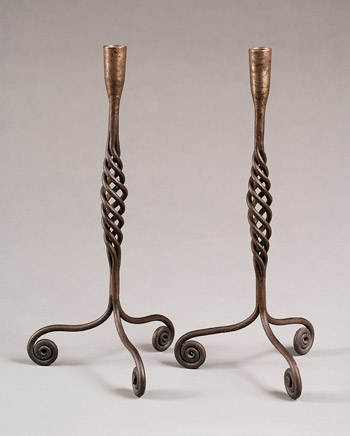Deerfield Arts & Crafts home page
Treasures
Wrought iron candleholders

© Memorial Hall Museum, Pocumtuck Valley Memorial Association
In "Design in theory and practice: a series of lessons: number III," appearing in The Craftsman (December 1907), Arts and Crafts tilemaker Ernest Batchelder describes the 'infinite curve' coined by mid-19th-century British Art critic John Ruskin: "It is the curve that Nature most loves, which she seems ever striving to attain." "Seek where you will," Batchelder concludes, "from the blade of grass to the shells on the beach, you will find this 'infinite curve,' the curve of living, growing things, of force and vitality."1 Of the opinion that the 'infinite curve' was ripe with design potential, Batchelder recommended it to Arts and Crafts artisans.
While it is now impossible to say whether Cornelius Kelley was aware of the thoughts of such design theorists as Ernest Batchelder, it is clear from the wrought iron candleholders pictured above, as well as his other work, that Deerfield's blacksmith possessed a sense for "the curve that Nature most loves," and that he could convey it through his iron creations.
- Ernest Batchelder, "Design in theory and practice: a series of lessons: number III,"The Craftsman December 1907, 332-3.
- Date:
- c. 1930
- Creator:
- Cornelius Kelley
- Dimensions:
- H. 15" x W. 6. 375" x Depth 6.5"